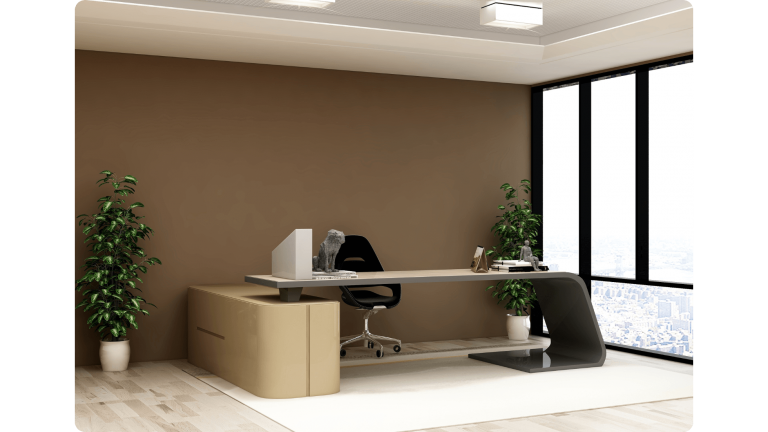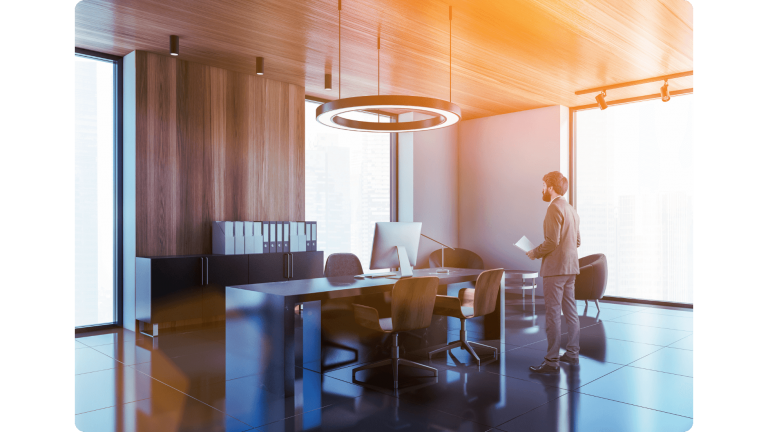
How to design an executive office
When it comes to designing an executive office, there are a few things to consider. The office should reflect the company’s values, image and philosophy. It should also be consistent with the rest of the company’s offices, without being too similar or too different.
Even though open spaces are becoming increasingly popular in offices, executive offices still tend to be closed off from the rest of the workspace. This is due to the fact that they need to keep privacy and multifunctionality.
In this article, we will give you some tips for designing your executive office, including what type of furniture it should incorporate.
What should I consider when designing an executive office?
There are many elements to consider when designing an executive office, including the choice of furniture, wall layout and colors, or finishes and overall style. The office layout should be designed to promote collaboration, comfort and efficiency.
Furniture should be ergonomically designed to allow for proper seating and support for the arms and back. Chairs, armchairs and sofas should also have colors that match the overall aesthetic of the room. It is important to choose sturdy furniture with durable materials that can withstand heavy use.
Wall colors should be chosen based on the type of work that will be done in the office. A room that is intended for meetings and collaboration can benefit from a lighter palette to stimulate creativity, while a room dedicated to efficiency and increased performance can have a darker mood to promote a more focused atmosphere.
Finishes such as ceilings, baseboards, trim and other decorative details should be chosen based on the needs of the office. Finishes help complement the overall style and create an atmosphere that reflects the company’s brand image. It is important to consider these elements carefully to create a comfortable and productive space for everyone who will be working or meeting in the office.

Why does the executive office tend to be closed off from the rest of the workspace?
The executive office is usually more enclosed and separated from the rest of the workspace to maintain privacy and discretion. Executives often need a quiet atmosphere to deliberate, make decisions and discuss strategic issues that do not need to be shared with other employees. Meeting rooms in the executive office also provide some protection for executives from interruptions and distractions, allowing executives the peace and quiet they need to focus on their tasks
Additionally, the executive office can serve to create a sense of authority and prestige between executives and other staff members. A space furnished with high-end furniture, artifacts and designs that reflect social status can give business leaders an added advantage when communicating with clients or staff.

What type of furniture should be placed in the executive office?
The furniture to be included in the executive office should offer a sense of luxury and prestige, while presenting an elegant and refined aesthetic. A good choice would be to invest in high-end furniture made from sturdy, durable materials that are designed to retain their quality and beauty over the years. Materials used for this type of furniture can include leather or high-end fabrics, as well as solid wood or metal. The choice of colors and tones should also be carefully considered to provide a chic and modern look to the office. The layout of the furniture should also be considered, as it allows staff members to perform their tasks without disturbing others. Special attention should also be paid to ergonomics, so that the seating is perfectly suited to the bodies to allow for maximum productivity. Finally, accessories are essential to complete the decoration and give a unique touch to the space. Decorative plants as well as some modern art pieces can add a timeless finishing touch to the whole.
Additionally, it is important to incorporate ergonomic pieces to provide the most containment and increased productivity. Accessories are also a great way to personalize the executive office and give it a unique look that will stand out from the rest of the space. Once the furniture is integrated, plants or modern art pieces can add the finishing touch to your space. All of this together will create a luxurious aesthetic capable of encouraging employees to achieve their professional goals.

Some tips for designing your executive office
For both businesses and individuals, designing an executive office is essential to creating an environment that encourages concentration and productivity. Here are some tips to help you create an ergonomic and inspiring workspace
First, choose the right furniture. The desk should be spacious and comfortable enough to accommodate all the equipment you need and offer support for your back and neck. You’ll also want to be careful about the chairs you choose – they should have a good seat, adjustable height, a backrest and a breathable surface that allows air to circulate.
When it comes to style, opt for a neutral but attractive design that matches your professional image. Consider investing in useful accessories such as a wall calendar, a clock, or even personal supports such as green plants or decorative objects that reflect your personality.
Lighting is also very important as it can greatly influence your mood and performance at work. Opt for adequate natural lighting to facilitate concentration and physical well-being. Once this is accomplished, install additional lighting such as a desk lamp or ceiling pendant if necessary.
Designing your executive office isn’t just about choosing the right furniture; make sure you also consider some of the more practical aspects such as storage and organization so that your space is always organized and neat. To do so, you can create different compartments to store documents, pens, post-it notes, etc., invest in modular storage boxes or hang different corkboards on the walls to keep important notes or visual reminders of the work to be done.
Finally, take the time to properly configure your computer or other technological tools in order to optimize their use and performance; this includes the installation of a reliable antivirus system, the installation of specific software as well as the optimal configuration of computer equipment (ergonomic keyboard, etc.). This way you will get a practical and productive executive office!